Thomas Cook: Managing Customer Experience in the Travel Industry
VerifiedAdded on 2020/10/04
|17
|4158
|95
Report
AI Summary
This report analyzes customer experience management within Thomas Cook, a travel and tourism company. It begins by identifying the target market, emphasizing its benefits and importance, and explores factors influencing customer engagement across various customer groups, including business, adventure, and leisure tourists. The report then delves into customer journey mapping, outlining touchpoints and creating a customer journey model to understand and improve the customer experience. It examines the role of digital technologies, particularly CRM systems, in managing customer relationships. Furthermore, it provides an overview of customer service strategies, outlining policies, objectives, and recommendations for improvement. The report concludes with a comprehensive evaluation of customer experience, offering insights and recommendations for enhancing customer satisfaction and loyalty within Thomas Cook.
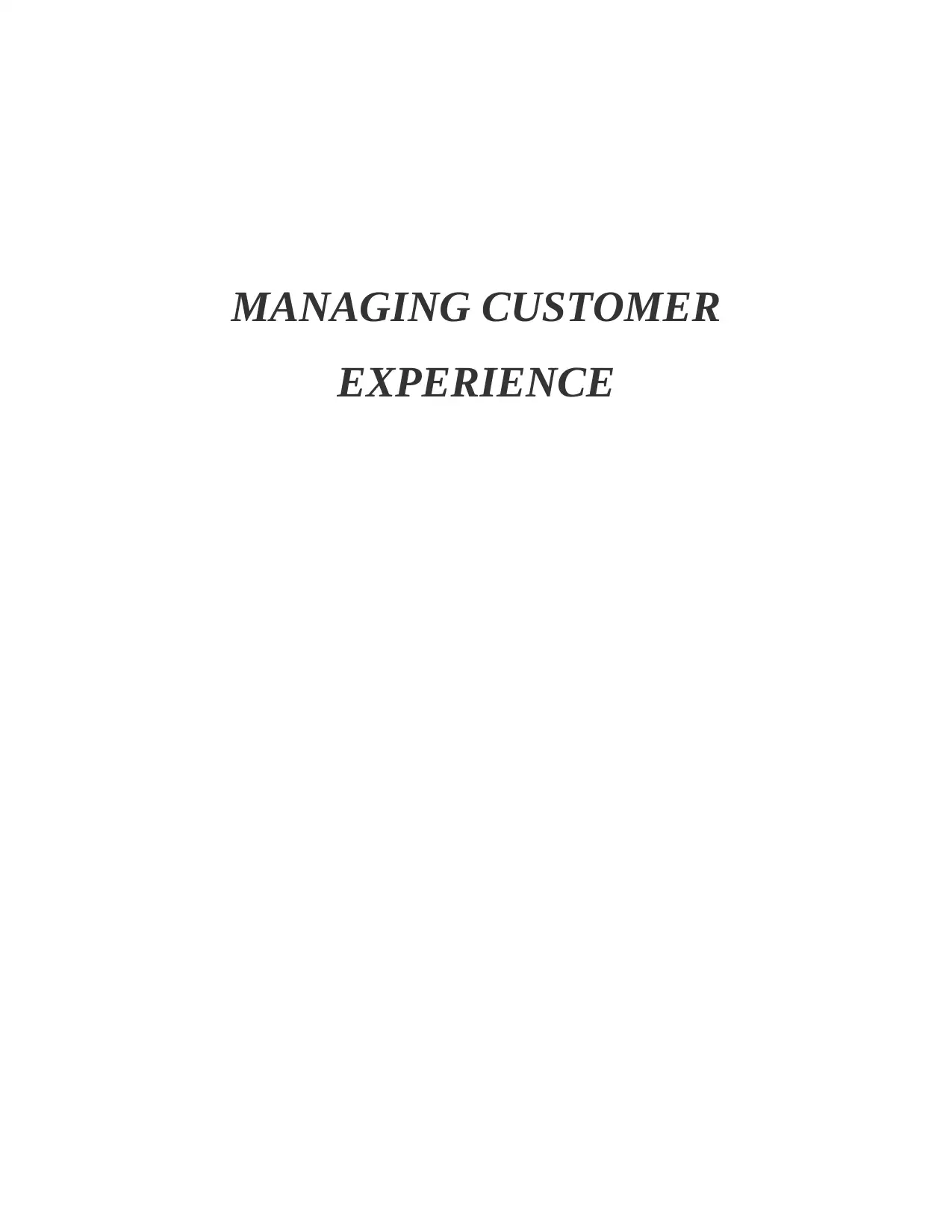
MANAGING CUSTOMER
EXPERIENCE
EXPERIENCE
Paraphrase This Document
Need a fresh take? Get an instant paraphrase of this document with our AI Paraphraser
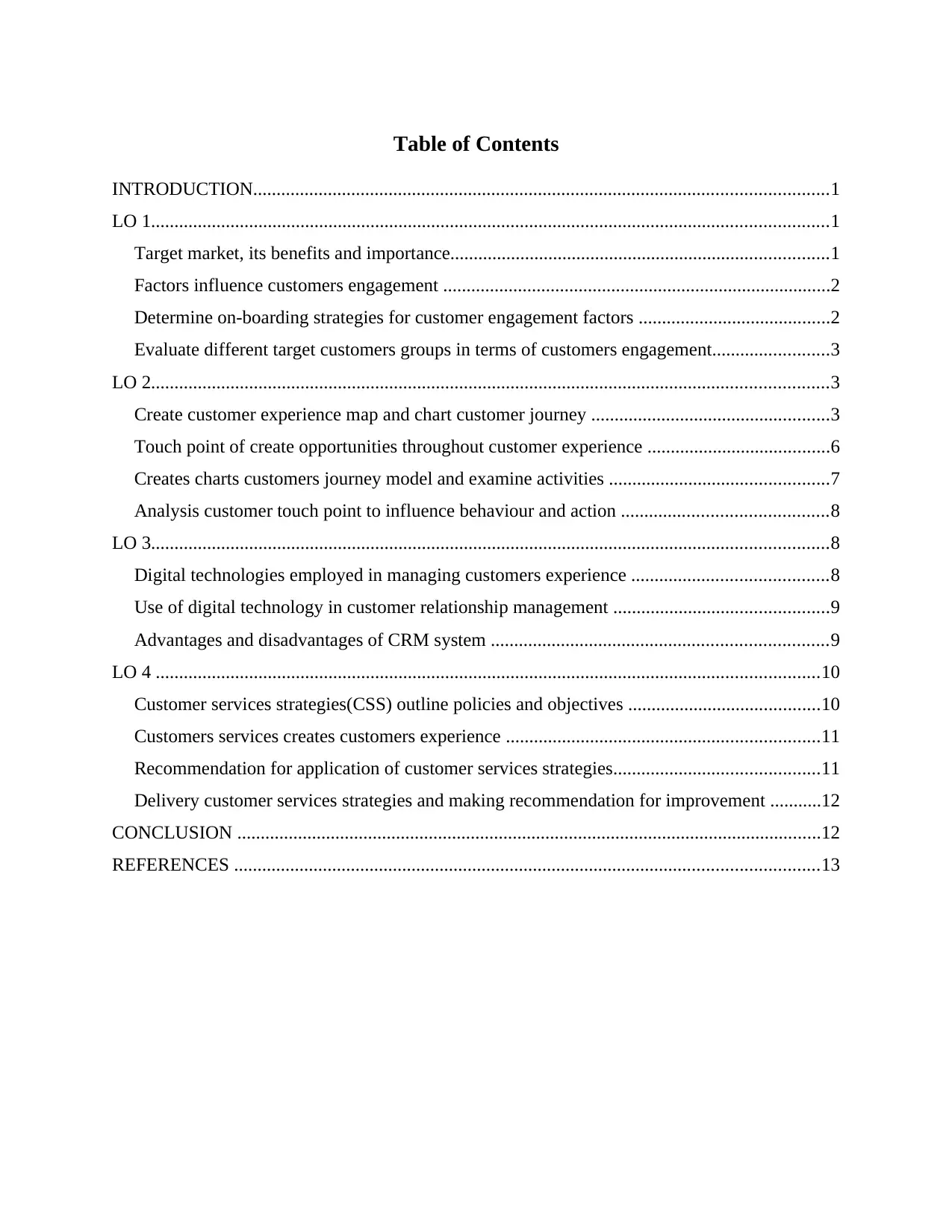
Table of Contents
INTRODUCTION...........................................................................................................................1
LO 1.................................................................................................................................................1
Target market, its benefits and importance.................................................................................1
Factors influence customers engagement ...................................................................................2
Determine on-boarding strategies for customer engagement factors .........................................2
Evaluate different target customers groups in terms of customers engagement.........................3
LO 2.................................................................................................................................................3
Create customer experience map and chart customer journey ...................................................3
Touch point of create opportunities throughout customer experience .......................................6
Creates charts customers journey model and examine activities ...............................................7
Analysis customer touch point to influence behaviour and action ............................................8
LO 3.................................................................................................................................................8
Digital technologies employed in managing customers experience ..........................................8
Use of digital technology in customer relationship management ..............................................9
Advantages and disadvantages of CRM system ........................................................................9
LO 4 ..............................................................................................................................................10
Customer services strategies(CSS) outline policies and objectives .........................................10
Customers services creates customers experience ...................................................................11
Recommendation for application of customer services strategies............................................11
Delivery customer services strategies and making recommendation for improvement ...........12
CONCLUSION .............................................................................................................................12
REFERENCES .............................................................................................................................13
INTRODUCTION...........................................................................................................................1
LO 1.................................................................................................................................................1
Target market, its benefits and importance.................................................................................1
Factors influence customers engagement ...................................................................................2
Determine on-boarding strategies for customer engagement factors .........................................2
Evaluate different target customers groups in terms of customers engagement.........................3
LO 2.................................................................................................................................................3
Create customer experience map and chart customer journey ...................................................3
Touch point of create opportunities throughout customer experience .......................................6
Creates charts customers journey model and examine activities ...............................................7
Analysis customer touch point to influence behaviour and action ............................................8
LO 3.................................................................................................................................................8
Digital technologies employed in managing customers experience ..........................................8
Use of digital technology in customer relationship management ..............................................9
Advantages and disadvantages of CRM system ........................................................................9
LO 4 ..............................................................................................................................................10
Customer services strategies(CSS) outline policies and objectives .........................................10
Customers services creates customers experience ...................................................................11
Recommendation for application of customer services strategies............................................11
Delivery customer services strategies and making recommendation for improvement ...........12
CONCLUSION .............................................................................................................................12
REFERENCES .............................................................................................................................13
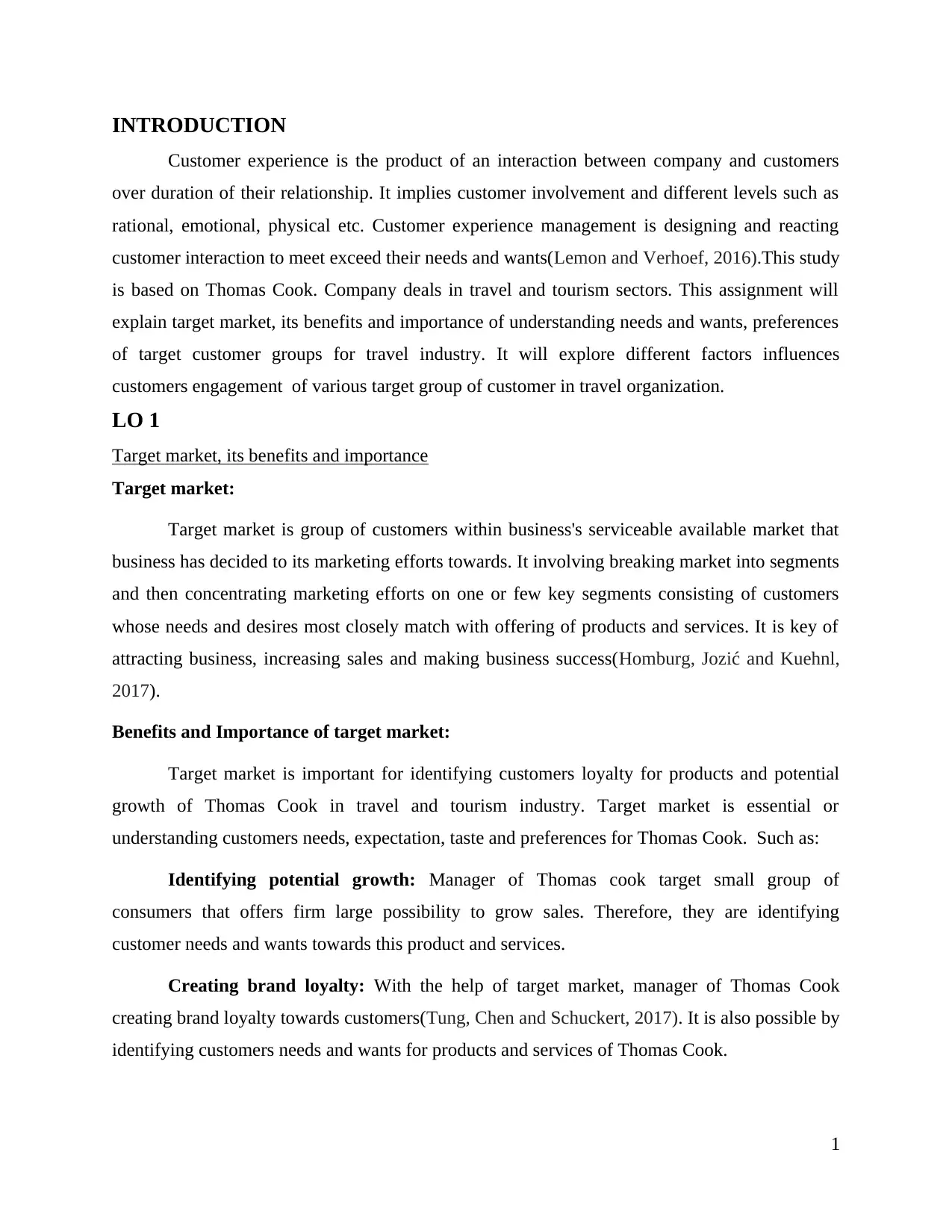
INTRODUCTION
Customer experience is the product of an interaction between company and customers
over duration of their relationship. It implies customer involvement and different levels such as
rational, emotional, physical etc. Customer experience management is designing and reacting
customer interaction to meet exceed their needs and wants(Lemon and Verhoef, 2016).This study
is based on Thomas Cook. Company deals in travel and tourism sectors. This assignment will
explain target market, its benefits and importance of understanding needs and wants, preferences
of target customer groups for travel industry. It will explore different factors influences
customers engagement of various target group of customer in travel organization.
LO 1
Target market, its benefits and importance
Target market:
Target market is group of customers within business's serviceable available market that
business has decided to its marketing efforts towards. It involving breaking market into segments
and then concentrating marketing efforts on one or few key segments consisting of customers
whose needs and desires most closely match with offering of products and services. It is key of
attracting business, increasing sales and making business success(Homburg, Jozić and Kuehnl,
2017).
Benefits and Importance of target market:
Target market is important for identifying customers loyalty for products and potential
growth of Thomas Cook in travel and tourism industry. Target market is essential or
understanding customers needs, expectation, taste and preferences for Thomas Cook. Such as:
Identifying potential growth: Manager of Thomas cook target small group of
consumers that offers firm large possibility to grow sales. Therefore, they are identifying
customer needs and wants towards this product and services.
Creating brand loyalty: With the help of target market, manager of Thomas Cook
creating brand loyalty towards customers(Tung, Chen and Schuckert, 2017). It is also possible by
identifying customers needs and wants for products and services of Thomas Cook.
1
Customer experience is the product of an interaction between company and customers
over duration of their relationship. It implies customer involvement and different levels such as
rational, emotional, physical etc. Customer experience management is designing and reacting
customer interaction to meet exceed their needs and wants(Lemon and Verhoef, 2016).This study
is based on Thomas Cook. Company deals in travel and tourism sectors. This assignment will
explain target market, its benefits and importance of understanding needs and wants, preferences
of target customer groups for travel industry. It will explore different factors influences
customers engagement of various target group of customer in travel organization.
LO 1
Target market, its benefits and importance
Target market:
Target market is group of customers within business's serviceable available market that
business has decided to its marketing efforts towards. It involving breaking market into segments
and then concentrating marketing efforts on one or few key segments consisting of customers
whose needs and desires most closely match with offering of products and services. It is key of
attracting business, increasing sales and making business success(Homburg, Jozić and Kuehnl,
2017).
Benefits and Importance of target market:
Target market is important for identifying customers loyalty for products and potential
growth of Thomas Cook in travel and tourism industry. Target market is essential or
understanding customers needs, expectation, taste and preferences for Thomas Cook. Such as:
Identifying potential growth: Manager of Thomas cook target small group of
consumers that offers firm large possibility to grow sales. Therefore, they are identifying
customer needs and wants towards this product and services.
Creating brand loyalty: With the help of target market, manager of Thomas Cook
creating brand loyalty towards customers(Tung, Chen and Schuckert, 2017). It is also possible by
identifying customers needs and wants for products and services of Thomas Cook.
1
⊘ This is a preview!⊘
Do you want full access?
Subscribe today to unlock all pages.

Trusted by 1+ million students worldwide
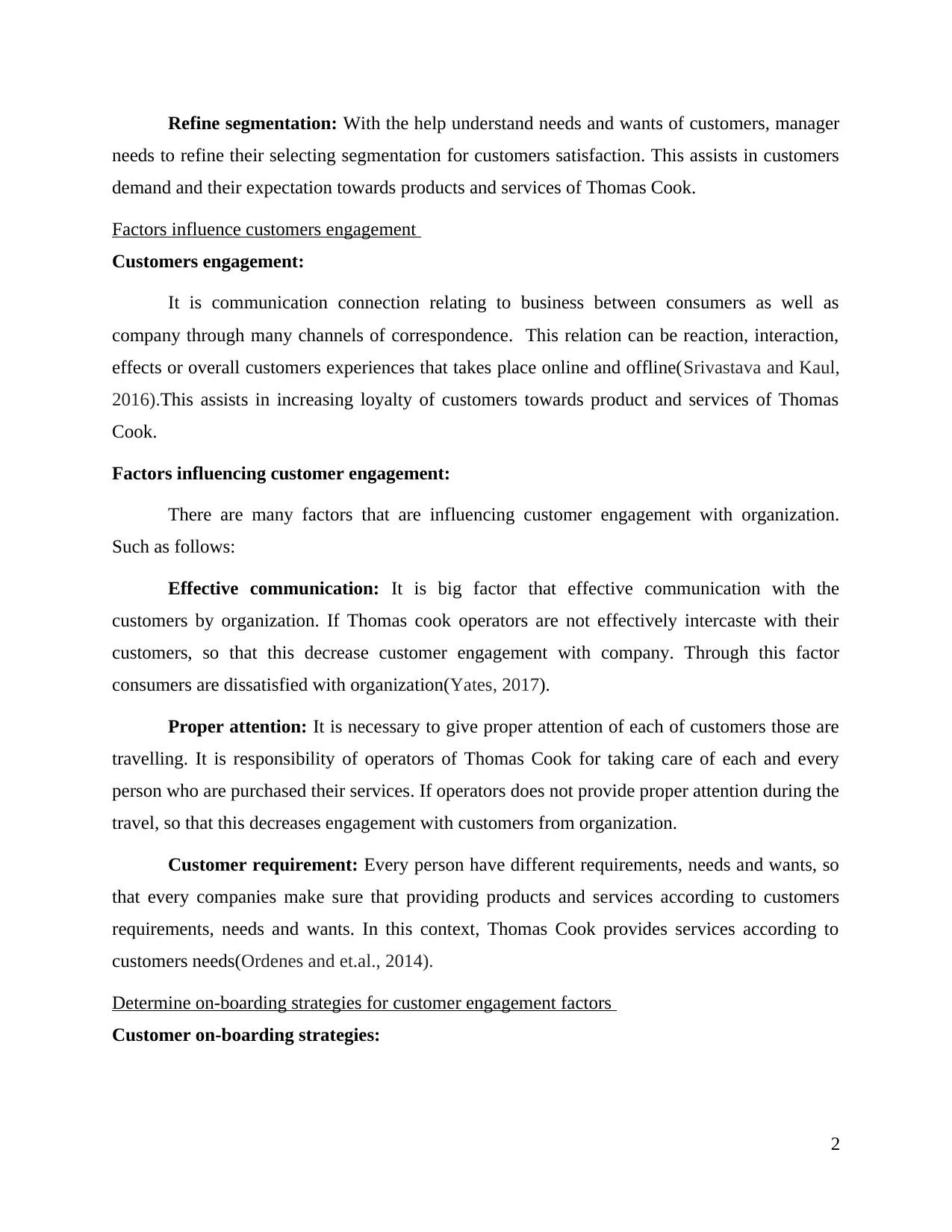
Refine segmentation: With the help understand needs and wants of customers, manager
needs to refine their selecting segmentation for customers satisfaction. This assists in customers
demand and their expectation towards products and services of Thomas Cook.
Factors influence customers engagement
Customers engagement:
It is communication connection relating to business between consumers as well as
company through many channels of correspondence. This relation can be reaction, interaction,
effects or overall customers experiences that takes place online and offline(Srivastava and Kaul,
2016).This assists in increasing loyalty of customers towards product and services of Thomas
Cook.
Factors influencing customer engagement:
There are many factors that are influencing customer engagement with organization.
Such as follows:
Effective communication: It is big factor that effective communication with the
customers by organization. If Thomas cook operators are not effectively intercaste with their
customers, so that this decrease customer engagement with company. Through this factor
consumers are dissatisfied with organization(Yates, 2017).
Proper attention: It is necessary to give proper attention of each of customers those are
travelling. It is responsibility of operators of Thomas Cook for taking care of each and every
person who are purchased their services. If operators does not provide proper attention during the
travel, so that this decreases engagement with customers from organization.
Customer requirement: Every person have different requirements, needs and wants, so
that every companies make sure that providing products and services according to customers
requirements, needs and wants. In this context, Thomas Cook provides services according to
customers needs(Ordenes and et.al., 2014).
Determine on-boarding strategies for customer engagement factors
Customer on-boarding strategies:
2
needs to refine their selecting segmentation for customers satisfaction. This assists in customers
demand and their expectation towards products and services of Thomas Cook.
Factors influence customers engagement
Customers engagement:
It is communication connection relating to business between consumers as well as
company through many channels of correspondence. This relation can be reaction, interaction,
effects or overall customers experiences that takes place online and offline(Srivastava and Kaul,
2016).This assists in increasing loyalty of customers towards product and services of Thomas
Cook.
Factors influencing customer engagement:
There are many factors that are influencing customer engagement with organization.
Such as follows:
Effective communication: It is big factor that effective communication with the
customers by organization. If Thomas cook operators are not effectively intercaste with their
customers, so that this decrease customer engagement with company. Through this factor
consumers are dissatisfied with organization(Yates, 2017).
Proper attention: It is necessary to give proper attention of each of customers those are
travelling. It is responsibility of operators of Thomas Cook for taking care of each and every
person who are purchased their services. If operators does not provide proper attention during the
travel, so that this decreases engagement with customers from organization.
Customer requirement: Every person have different requirements, needs and wants, so
that every companies make sure that providing products and services according to customers
requirements, needs and wants. In this context, Thomas Cook provides services according to
customers needs(Ordenes and et.al., 2014).
Determine on-boarding strategies for customer engagement factors
Customer on-boarding strategies:
2
Paraphrase This Document
Need a fresh take? Get an instant paraphrase of this document with our AI Paraphraser
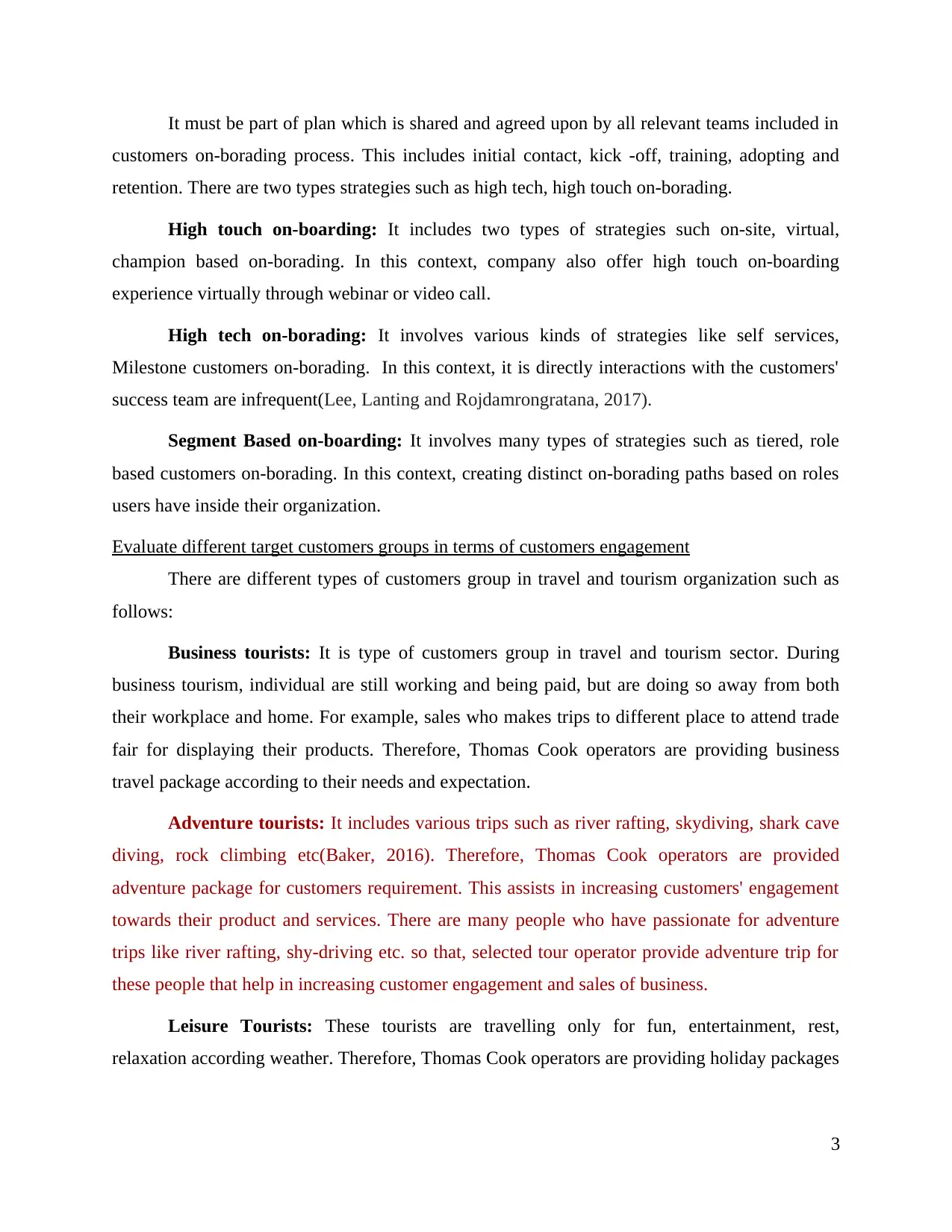
It must be part of plan which is shared and agreed upon by all relevant teams included in
customers on-borading process. This includes initial contact, kick -off, training, adopting and
retention. There are two types strategies such as high tech, high touch on-borading.
High touch on-boarding: It includes two types of strategies such on-site, virtual,
champion based on-borading. In this context, company also offer high touch on-boarding
experience virtually through webinar or video call.
High tech on-borading: It involves various kinds of strategies like self services,
Milestone customers on-borading. In this context, it is directly interactions with the customers'
success team are infrequent(Lee, Lanting and Rojdamrongratana, 2017).
Segment Based on-boarding: It involves many types of strategies such as tiered, role
based customers on-borading. In this context, creating distinct on-borading paths based on roles
users have inside their organization.
Evaluate different target customers groups in terms of customers engagement
There are different types of customers group in travel and tourism organization such as
follows:
Business tourists: It is type of customers group in travel and tourism sector. During
business tourism, individual are still working and being paid, but are doing so away from both
their workplace and home. For example, sales who makes trips to different place to attend trade
fair for displaying their products. Therefore, Thomas Cook operators are providing business
travel package according to their needs and expectation.
Adventure tourists: It includes various trips such as river rafting, skydiving, shark cave
diving, rock climbing etc(Baker, 2016). Therefore, Thomas Cook operators are provided
adventure package for customers requirement. This assists in increasing customers' engagement
towards their product and services. There are many people who have passionate for adventure
trips like river rafting, shy-driving etc. so that, selected tour operator provide adventure trip for
these people that help in increasing customer engagement and sales of business.
Leisure Tourists: These tourists are travelling only for fun, entertainment, rest,
relaxation according weather. Therefore, Thomas Cook operators are providing holiday packages
3
customers on-borading process. This includes initial contact, kick -off, training, adopting and
retention. There are two types strategies such as high tech, high touch on-borading.
High touch on-boarding: It includes two types of strategies such on-site, virtual,
champion based on-borading. In this context, company also offer high touch on-boarding
experience virtually through webinar or video call.
High tech on-borading: It involves various kinds of strategies like self services,
Milestone customers on-borading. In this context, it is directly interactions with the customers'
success team are infrequent(Lee, Lanting and Rojdamrongratana, 2017).
Segment Based on-boarding: It involves many types of strategies such as tiered, role
based customers on-borading. In this context, creating distinct on-borading paths based on roles
users have inside their organization.
Evaluate different target customers groups in terms of customers engagement
There are different types of customers group in travel and tourism organization such as
follows:
Business tourists: It is type of customers group in travel and tourism sector. During
business tourism, individual are still working and being paid, but are doing so away from both
their workplace and home. For example, sales who makes trips to different place to attend trade
fair for displaying their products. Therefore, Thomas Cook operators are providing business
travel package according to their needs and expectation.
Adventure tourists: It includes various trips such as river rafting, skydiving, shark cave
diving, rock climbing etc(Baker, 2016). Therefore, Thomas Cook operators are provided
adventure package for customers requirement. This assists in increasing customers' engagement
towards their product and services. There are many people who have passionate for adventure
trips like river rafting, shy-driving etc. so that, selected tour operator provide adventure trip for
these people that help in increasing customer engagement and sales of business.
Leisure Tourists: These tourists are travelling only for fun, entertainment, rest,
relaxation according weather. Therefore, Thomas Cook operators are providing holiday packages
3
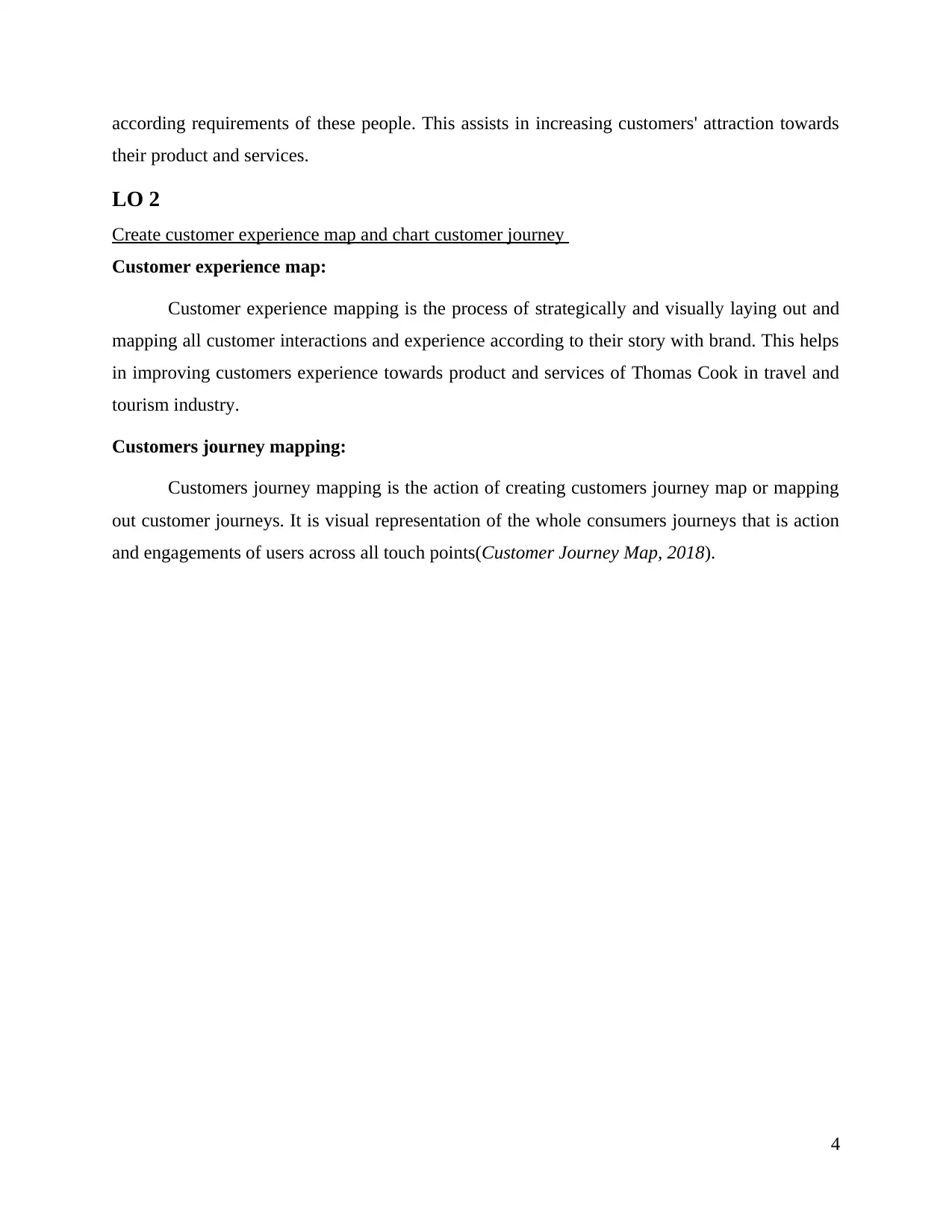
according requirements of these people. This assists in increasing customers' attraction towards
their product and services.
LO 2
Create customer experience map and chart customer journey
Customer experience map:
Customer experience mapping is the process of strategically and visually laying out and
mapping all customer interactions and experience according to their story with brand. This helps
in improving customers experience towards product and services of Thomas Cook in travel and
tourism industry.
Customers journey mapping:
Customers journey mapping is the action of creating customers journey map or mapping
out customer journeys. It is visual representation of the whole consumers journeys that is action
and engagements of users across all touch points(Customer Journey Map, 2018).
4
their product and services.
LO 2
Create customer experience map and chart customer journey
Customer experience map:
Customer experience mapping is the process of strategically and visually laying out and
mapping all customer interactions and experience according to their story with brand. This helps
in improving customers experience towards product and services of Thomas Cook in travel and
tourism industry.
Customers journey mapping:
Customers journey mapping is the action of creating customers journey map or mapping
out customer journeys. It is visual representation of the whole consumers journeys that is action
and engagements of users across all touch points(Customer Journey Map, 2018).
4
⊘ This is a preview!⊘
Do you want full access?
Subscribe today to unlock all pages.

Trusted by 1+ million students worldwide
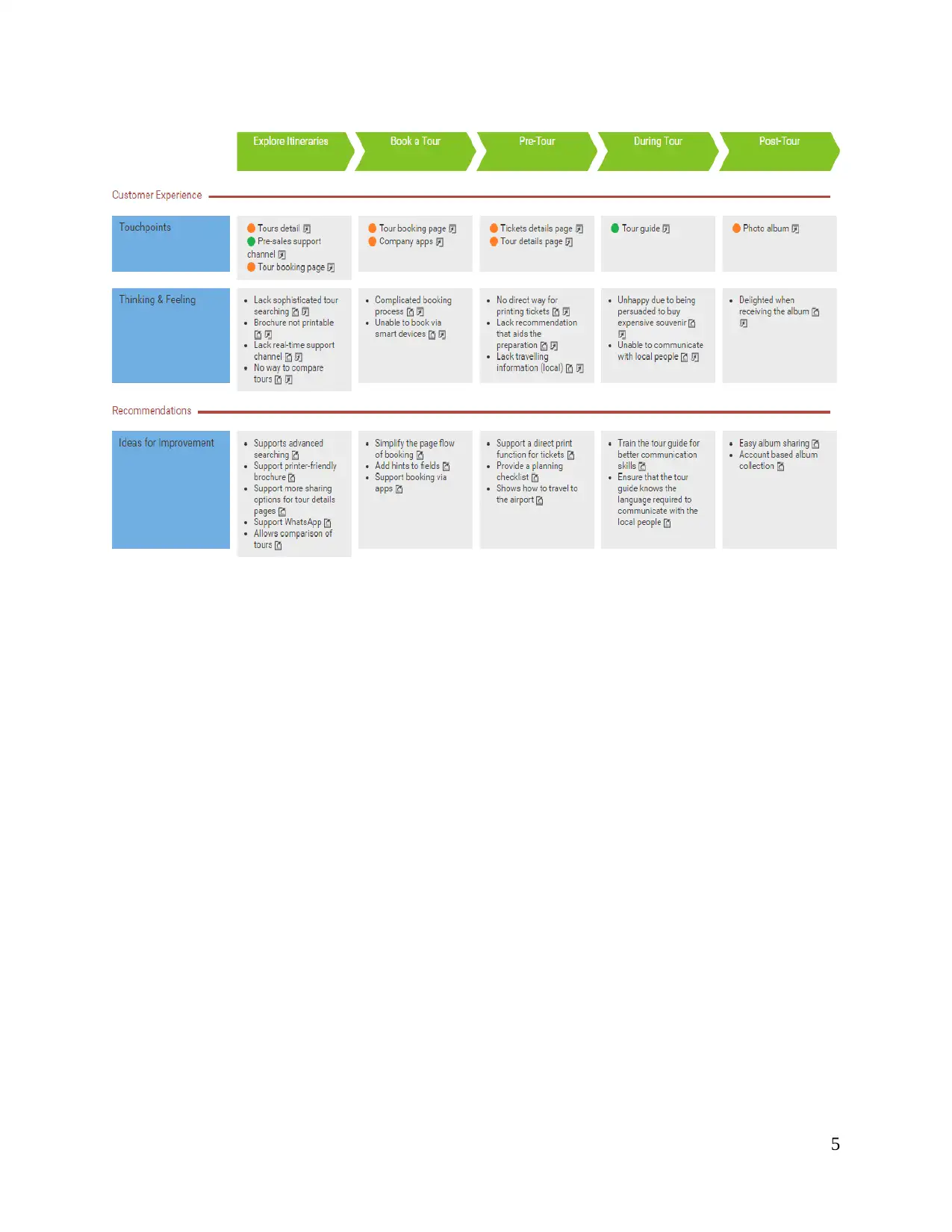
5
Paraphrase This Document
Need a fresh take? Get an instant paraphrase of this document with our AI Paraphraser
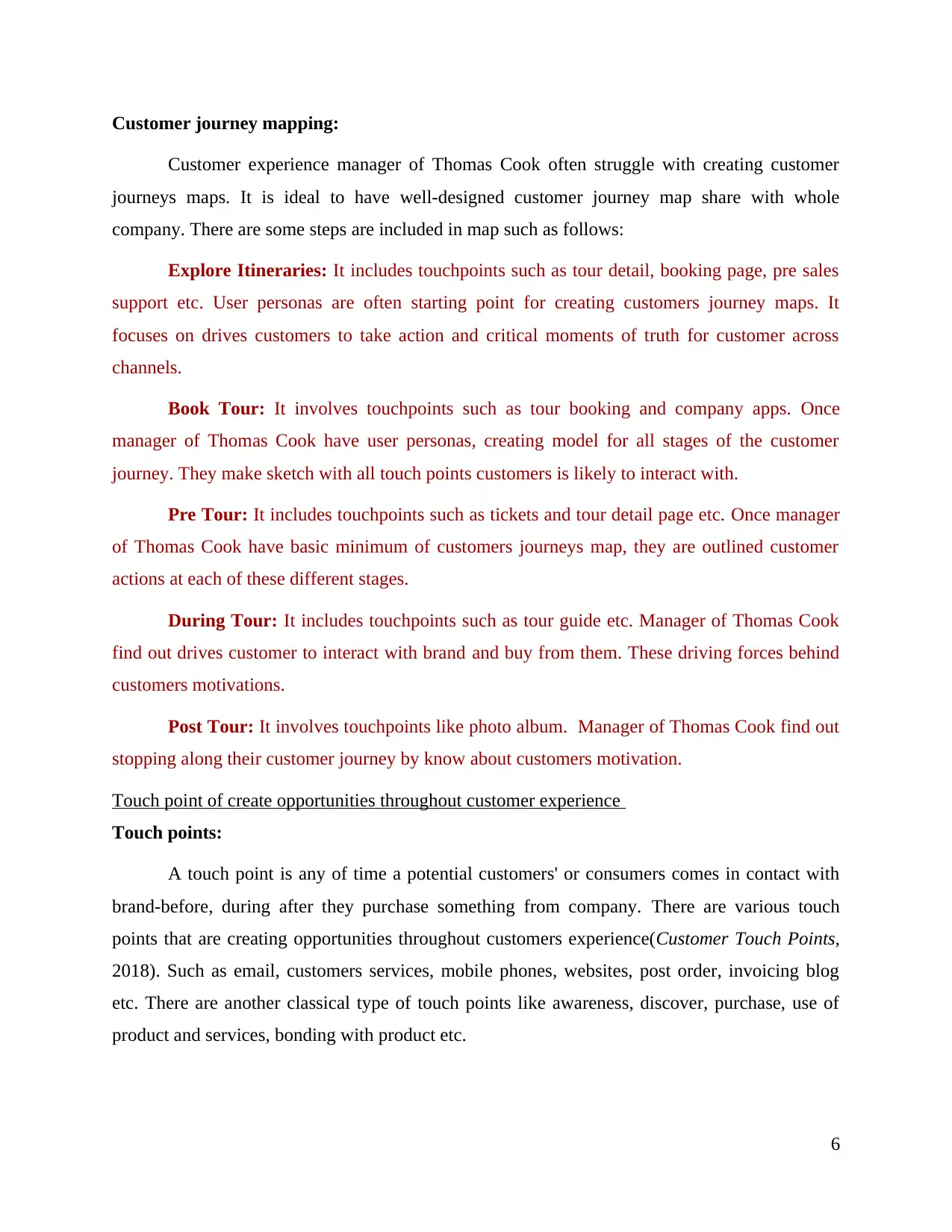
Customer journey mapping:
Customer experience manager of Thomas Cook often struggle with creating customer
journeys maps. It is ideal to have well-designed customer journey map share with whole
company. There are some steps are included in map such as follows:
Explore Itineraries: It includes touchpoints such as tour detail, booking page, pre sales
support etc. User personas are often starting point for creating customers journey maps. It
focuses on drives customers to take action and critical moments of truth for customer across
channels.
Book Tour: It involves touchpoints such as tour booking and company apps. Once
manager of Thomas Cook have user personas, creating model for all stages of the customer
journey. They make sketch with all touch points customers is likely to interact with.
Pre Tour: It includes touchpoints such as tickets and tour detail page etc. Once manager
of Thomas Cook have basic minimum of customers journeys map, they are outlined customer
actions at each of these different stages.
During Tour: It includes touchpoints such as tour guide etc. Manager of Thomas Cook
find out drives customer to interact with brand and buy from them. These driving forces behind
customers motivations.
Post Tour: It involves touchpoints like photo album. Manager of Thomas Cook find out
stopping along their customer journey by know about customers motivation.
Touch point of create opportunities throughout customer experience
Touch points:
A touch point is any of time a potential customers' or consumers comes in contact with
brand-before, during after they purchase something from company. There are various touch
points that are creating opportunities throughout customers experience(Customer Touch Points,
2018). Such as email, customers services, mobile phones, websites, post order, invoicing blog
etc. There are another classical type of touch points like awareness, discover, purchase, use of
product and services, bonding with product etc.
6
Customer experience manager of Thomas Cook often struggle with creating customer
journeys maps. It is ideal to have well-designed customer journey map share with whole
company. There are some steps are included in map such as follows:
Explore Itineraries: It includes touchpoints such as tour detail, booking page, pre sales
support etc. User personas are often starting point for creating customers journey maps. It
focuses on drives customers to take action and critical moments of truth for customer across
channels.
Book Tour: It involves touchpoints such as tour booking and company apps. Once
manager of Thomas Cook have user personas, creating model for all stages of the customer
journey. They make sketch with all touch points customers is likely to interact with.
Pre Tour: It includes touchpoints such as tickets and tour detail page etc. Once manager
of Thomas Cook have basic minimum of customers journeys map, they are outlined customer
actions at each of these different stages.
During Tour: It includes touchpoints such as tour guide etc. Manager of Thomas Cook
find out drives customer to interact with brand and buy from them. These driving forces behind
customers motivations.
Post Tour: It involves touchpoints like photo album. Manager of Thomas Cook find out
stopping along their customer journey by know about customers motivation.
Touch point of create opportunities throughout customer experience
Touch points:
A touch point is any of time a potential customers' or consumers comes in contact with
brand-before, during after they purchase something from company. There are various touch
points that are creating opportunities throughout customers experience(Customer Touch Points,
2018). Such as email, customers services, mobile phones, websites, post order, invoicing blog
etc. There are another classical type of touch points like awareness, discover, purchase, use of
product and services, bonding with product etc.
6
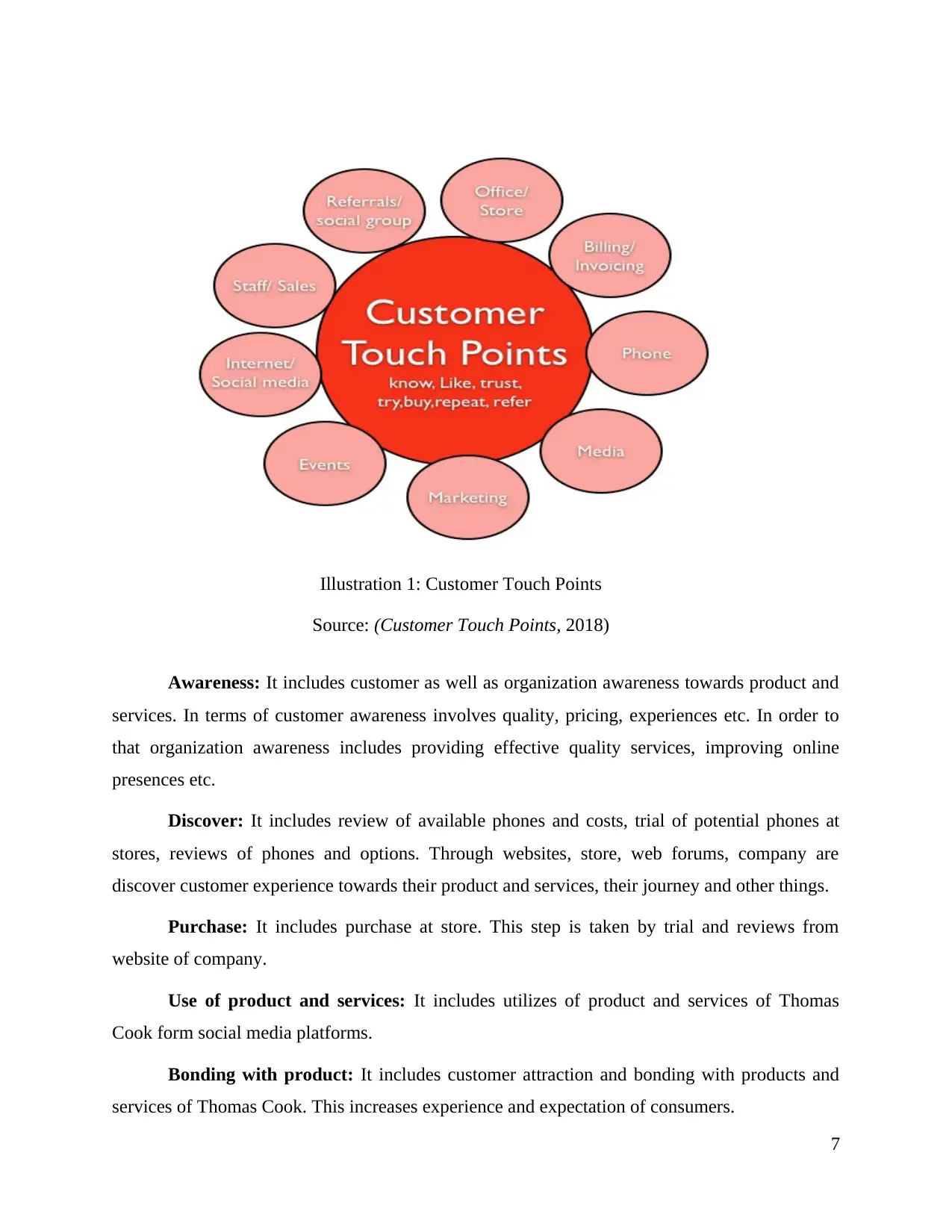
Awareness: It includes customer as well as organization awareness towards product and
services. In terms of customer awareness involves quality, pricing, experiences etc. In order to
that organization awareness includes providing effective quality services, improving online
presences etc.
Discover: It includes review of available phones and costs, trial of potential phones at
stores, reviews of phones and options. Through websites, store, web forums, company are
discover customer experience towards their product and services, their journey and other things.
Purchase: It includes purchase at store. This step is taken by trial and reviews from
website of company.
Use of product and services: It includes utilizes of product and services of Thomas
Cook form social media platforms.
Bonding with product: It includes customer attraction and bonding with products and
services of Thomas Cook. This increases experience and expectation of consumers.
7
Illustration 1: Customer Touch Points
Source: (Customer Touch Points, 2018)
services. In terms of customer awareness involves quality, pricing, experiences etc. In order to
that organization awareness includes providing effective quality services, improving online
presences etc.
Discover: It includes review of available phones and costs, trial of potential phones at
stores, reviews of phones and options. Through websites, store, web forums, company are
discover customer experience towards their product and services, their journey and other things.
Purchase: It includes purchase at store. This step is taken by trial and reviews from
website of company.
Use of product and services: It includes utilizes of product and services of Thomas
Cook form social media platforms.
Bonding with product: It includes customer attraction and bonding with products and
services of Thomas Cook. This increases experience and expectation of consumers.
7
Illustration 1: Customer Touch Points
Source: (Customer Touch Points, 2018)
⊘ This is a preview!⊘
Do you want full access?
Subscribe today to unlock all pages.

Trusted by 1+ million students worldwide
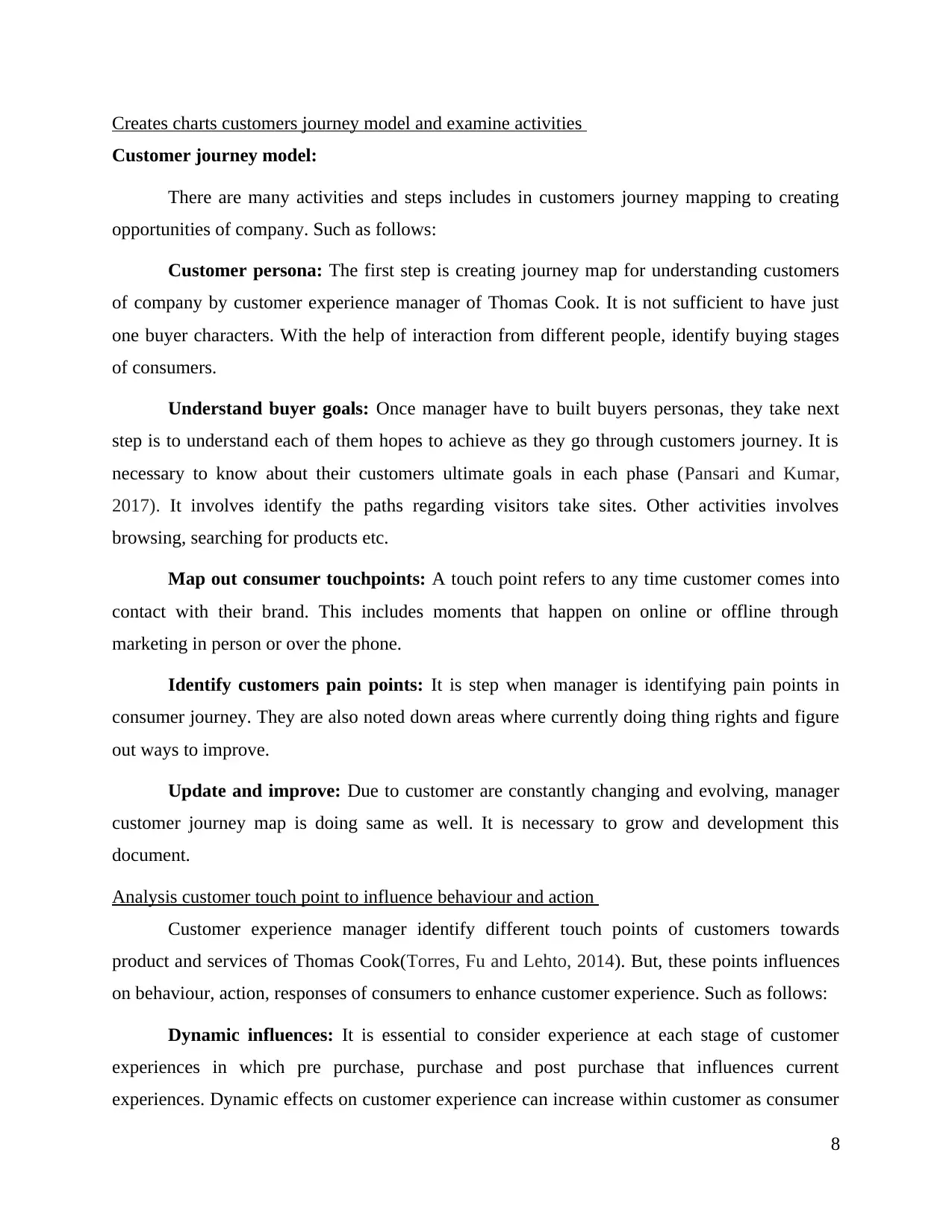
Creates charts customers journey model and examine activities
Customer journey model:
There are many activities and steps includes in customers journey mapping to creating
opportunities of company. Such as follows:
Customer persona: The first step is creating journey map for understanding customers
of company by customer experience manager of Thomas Cook. It is not sufficient to have just
one buyer characters. With the help of interaction from different people, identify buying stages
of consumers.
Understand buyer goals: Once manager have to built buyers personas, they take next
step is to understand each of them hopes to achieve as they go through customers journey. It is
necessary to know about their customers ultimate goals in each phase (Pansari and Kumar,
2017). It involves identify the paths regarding visitors take sites. Other activities involves
browsing, searching for products etc.
Map out consumer touchpoints: A touch point refers to any time customer comes into
contact with their brand. This includes moments that happen on online or offline through
marketing in person or over the phone.
Identify customers pain points: It is step when manager is identifying pain points in
consumer journey. They are also noted down areas where currently doing thing rights and figure
out ways to improve.
Update and improve: Due to customer are constantly changing and evolving, manager
customer journey map is doing same as well. It is necessary to grow and development this
document.
Analysis customer touch point to influence behaviour and action
Customer experience manager identify different touch points of customers towards
product and services of Thomas Cook(Torres, Fu and Lehto, 2014). But, these points influences
on behaviour, action, responses of consumers to enhance customer experience. Such as follows:
Dynamic influences: It is essential to consider experience at each stage of customer
experiences in which pre purchase, purchase and post purchase that influences current
experiences. Dynamic effects on customer experience can increase within customer as consumer
8
Customer journey model:
There are many activities and steps includes in customers journey mapping to creating
opportunities of company. Such as follows:
Customer persona: The first step is creating journey map for understanding customers
of company by customer experience manager of Thomas Cook. It is not sufficient to have just
one buyer characters. With the help of interaction from different people, identify buying stages
of consumers.
Understand buyer goals: Once manager have to built buyers personas, they take next
step is to understand each of them hopes to achieve as they go through customers journey. It is
necessary to know about their customers ultimate goals in each phase (Pansari and Kumar,
2017). It involves identify the paths regarding visitors take sites. Other activities involves
browsing, searching for products etc.
Map out consumer touchpoints: A touch point refers to any time customer comes into
contact with their brand. This includes moments that happen on online or offline through
marketing in person or over the phone.
Identify customers pain points: It is step when manager is identifying pain points in
consumer journey. They are also noted down areas where currently doing thing rights and figure
out ways to improve.
Update and improve: Due to customer are constantly changing and evolving, manager
customer journey map is doing same as well. It is necessary to grow and development this
document.
Analysis customer touch point to influence behaviour and action
Customer experience manager identify different touch points of customers towards
product and services of Thomas Cook(Torres, Fu and Lehto, 2014). But, these points influences
on behaviour, action, responses of consumers to enhance customer experience. Such as follows:
Dynamic influences: It is essential to consider experience at each stage of customer
experiences in which pre purchase, purchase and post purchase that influences current
experiences. Dynamic effects on customer experience can increase within customer as consumer
8
Paraphrase This Document
Need a fresh take? Get an instant paraphrase of this document with our AI Paraphraser
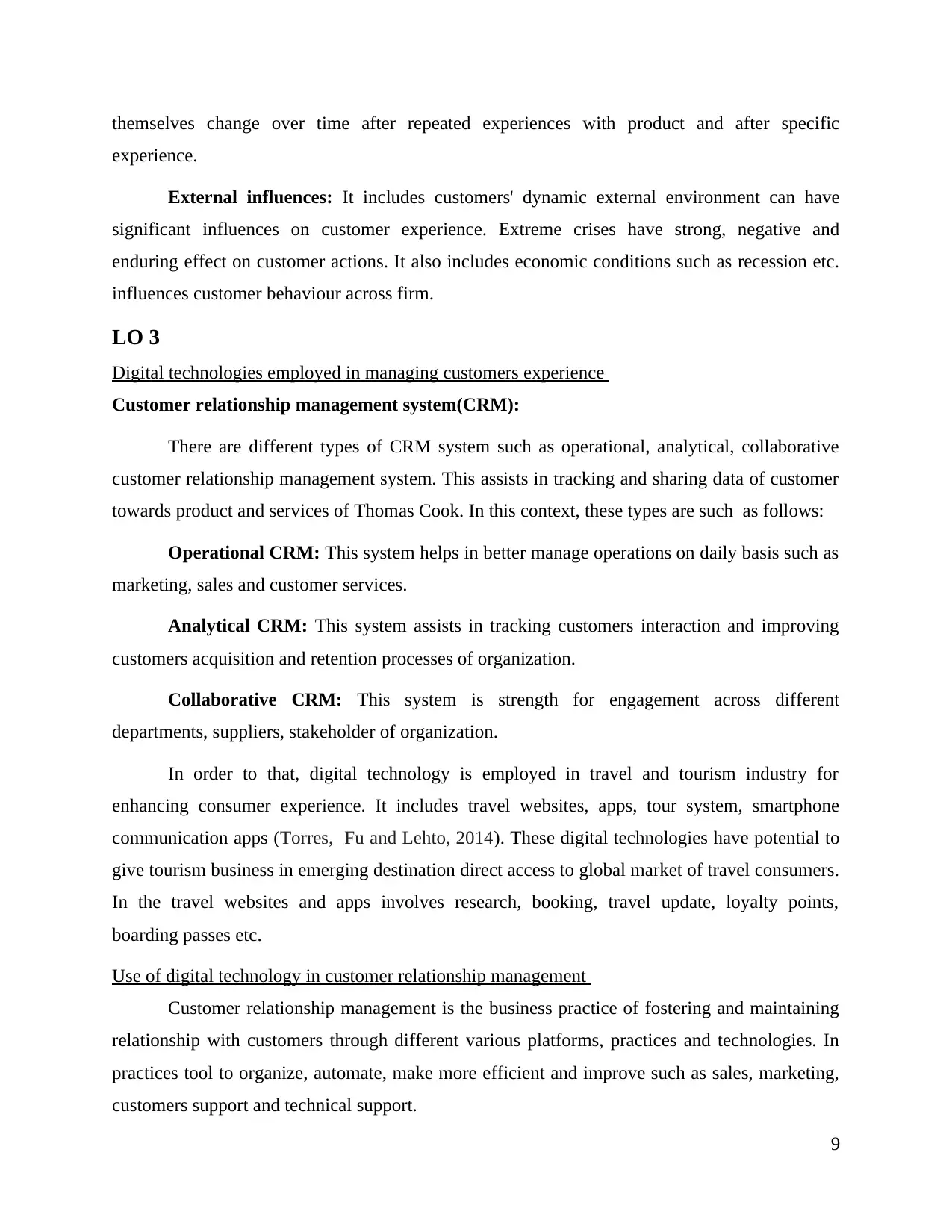
themselves change over time after repeated experiences with product and after specific
experience.
External influences: It includes customers' dynamic external environment can have
significant influences on customer experience. Extreme crises have strong, negative and
enduring effect on customer actions. It also includes economic conditions such as recession etc.
influences customer behaviour across firm.
LO 3
Digital technologies employed in managing customers experience
Customer relationship management system(CRM):
There are different types of CRM system such as operational, analytical, collaborative
customer relationship management system. This assists in tracking and sharing data of customer
towards product and services of Thomas Cook. In this context, these types are such as follows:
Operational CRM: This system helps in better manage operations on daily basis such as
marketing, sales and customer services.
Analytical CRM: This system assists in tracking customers interaction and improving
customers acquisition and retention processes of organization.
Collaborative CRM: This system is strength for engagement across different
departments, suppliers, stakeholder of organization.
In order to that, digital technology is employed in travel and tourism industry for
enhancing consumer experience. It includes travel websites, apps, tour system, smartphone
communication apps (Torres, Fu and Lehto, 2014). These digital technologies have potential to
give tourism business in emerging destination direct access to global market of travel consumers.
In the travel websites and apps involves research, booking, travel update, loyalty points,
boarding passes etc.
Use of digital technology in customer relationship management
Customer relationship management is the business practice of fostering and maintaining
relationship with customers through different various platforms, practices and technologies. In
practices tool to organize, automate, make more efficient and improve such as sales, marketing,
customers support and technical support.
9
experience.
External influences: It includes customers' dynamic external environment can have
significant influences on customer experience. Extreme crises have strong, negative and
enduring effect on customer actions. It also includes economic conditions such as recession etc.
influences customer behaviour across firm.
LO 3
Digital technologies employed in managing customers experience
Customer relationship management system(CRM):
There are different types of CRM system such as operational, analytical, collaborative
customer relationship management system. This assists in tracking and sharing data of customer
towards product and services of Thomas Cook. In this context, these types are such as follows:
Operational CRM: This system helps in better manage operations on daily basis such as
marketing, sales and customer services.
Analytical CRM: This system assists in tracking customers interaction and improving
customers acquisition and retention processes of organization.
Collaborative CRM: This system is strength for engagement across different
departments, suppliers, stakeholder of organization.
In order to that, digital technology is employed in travel and tourism industry for
enhancing consumer experience. It includes travel websites, apps, tour system, smartphone
communication apps (Torres, Fu and Lehto, 2014). These digital technologies have potential to
give tourism business in emerging destination direct access to global market of travel consumers.
In the travel websites and apps involves research, booking, travel update, loyalty points,
boarding passes etc.
Use of digital technology in customer relationship management
Customer relationship management is the business practice of fostering and maintaining
relationship with customers through different various platforms, practices and technologies. In
practices tool to organize, automate, make more efficient and improve such as sales, marketing,
customers support and technical support.
9
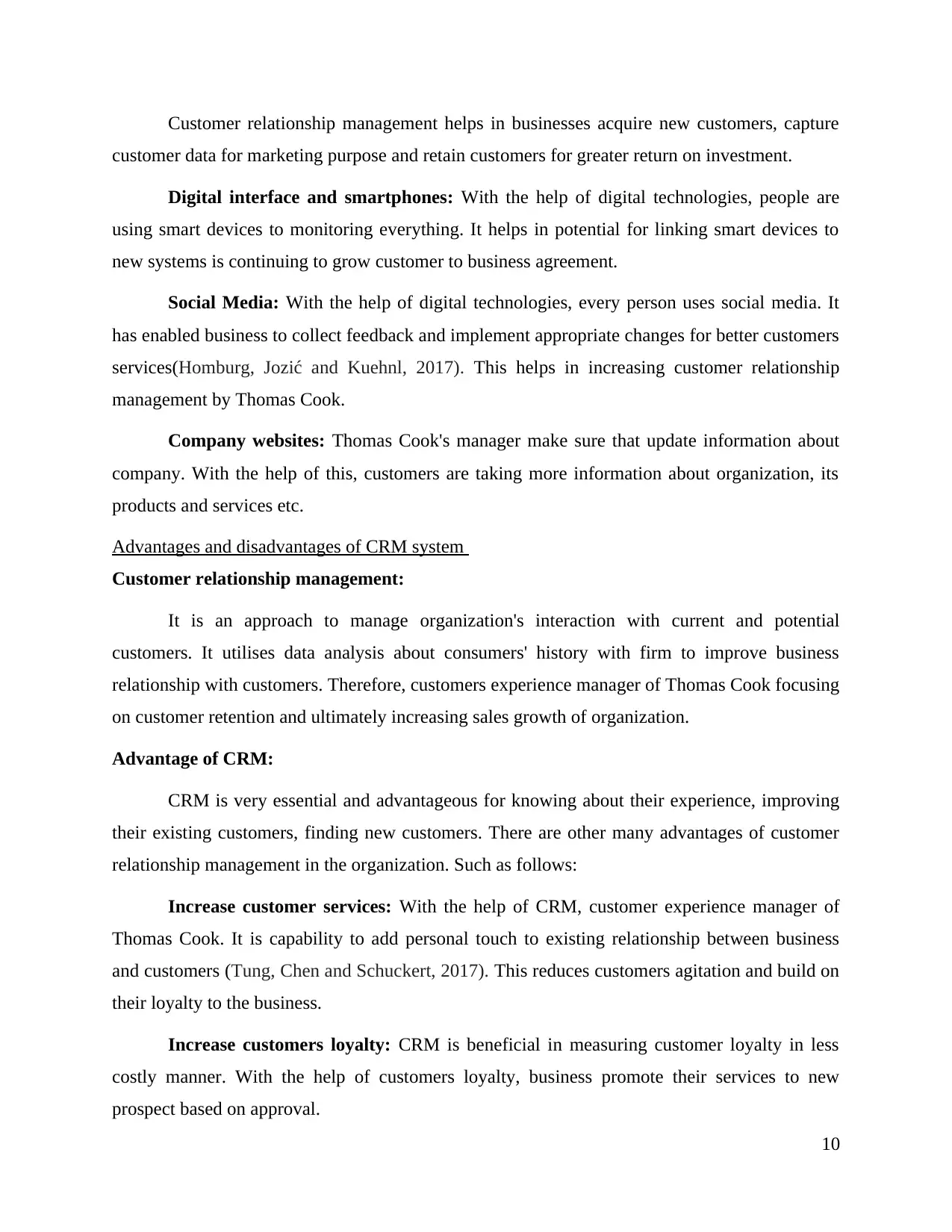
Customer relationship management helps in businesses acquire new customers, capture
customer data for marketing purpose and retain customers for greater return on investment.
Digital interface and smartphones: With the help of digital technologies, people are
using smart devices to monitoring everything. It helps in potential for linking smart devices to
new systems is continuing to grow customer to business agreement.
Social Media: With the help of digital technologies, every person uses social media. It
has enabled business to collect feedback and implement appropriate changes for better customers
services(Homburg, Jozić and Kuehnl, 2017). This helps in increasing customer relationship
management by Thomas Cook.
Company websites: Thomas Cook's manager make sure that update information about
company. With the help of this, customers are taking more information about organization, its
products and services etc.
Advantages and disadvantages of CRM system
Customer relationship management:
It is an approach to manage organization's interaction with current and potential
customers. It utilises data analysis about consumers' history with firm to improve business
relationship with customers. Therefore, customers experience manager of Thomas Cook focusing
on customer retention and ultimately increasing sales growth of organization.
Advantage of CRM:
CRM is very essential and advantageous for knowing about their experience, improving
their existing customers, finding new customers. There are other many advantages of customer
relationship management in the organization. Such as follows:
Increase customer services: With the help of CRM, customer experience manager of
Thomas Cook. It is capability to add personal touch to existing relationship between business
and customers (Tung, Chen and Schuckert, 2017). This reduces customers agitation and build on
their loyalty to the business.
Increase customers loyalty: CRM is beneficial in measuring customer loyalty in less
costly manner. With the help of customers loyalty, business promote their services to new
prospect based on approval.
10
customer data for marketing purpose and retain customers for greater return on investment.
Digital interface and smartphones: With the help of digital technologies, people are
using smart devices to monitoring everything. It helps in potential for linking smart devices to
new systems is continuing to grow customer to business agreement.
Social Media: With the help of digital technologies, every person uses social media. It
has enabled business to collect feedback and implement appropriate changes for better customers
services(Homburg, Jozić and Kuehnl, 2017). This helps in increasing customer relationship
management by Thomas Cook.
Company websites: Thomas Cook's manager make sure that update information about
company. With the help of this, customers are taking more information about organization, its
products and services etc.
Advantages and disadvantages of CRM system
Customer relationship management:
It is an approach to manage organization's interaction with current and potential
customers. It utilises data analysis about consumers' history with firm to improve business
relationship with customers. Therefore, customers experience manager of Thomas Cook focusing
on customer retention and ultimately increasing sales growth of organization.
Advantage of CRM:
CRM is very essential and advantageous for knowing about their experience, improving
their existing customers, finding new customers. There are other many advantages of customer
relationship management in the organization. Such as follows:
Increase customer services: With the help of CRM, customer experience manager of
Thomas Cook. It is capability to add personal touch to existing relationship between business
and customers (Tung, Chen and Schuckert, 2017). This reduces customers agitation and build on
their loyalty to the business.
Increase customers loyalty: CRM is beneficial in measuring customer loyalty in less
costly manner. With the help of customers loyalty, business promote their services to new
prospect based on approval.
10
⊘ This is a preview!⊘
Do you want full access?
Subscribe today to unlock all pages.

Trusted by 1+ million students worldwide
1 out of 17
Related Documents
Your All-in-One AI-Powered Toolkit for Academic Success.
+13062052269
info@desklib.com
Available 24*7 on WhatsApp / Email
![[object Object]](/_next/static/media/star-bottom.7253800d.svg)
Unlock your academic potential
Copyright © 2020–2025 A2Z Services. All Rights Reserved. Developed and managed by ZUCOL.





